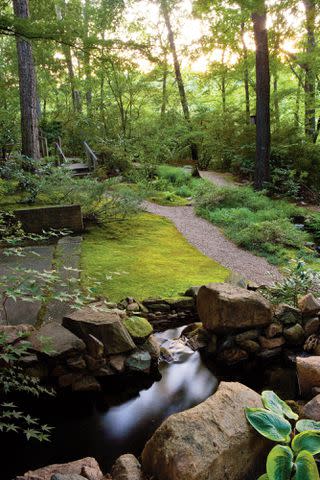How To Plant And Grow A Moss Lawn
Where a lawn won't grow, plant moss—no mowing, no fussing, no problem.

How would you like a lawn that stays green and beautiful year-round, is native to your area, grows just fine on bad soil, and needs hardly any weeding, watering, or fertilizing? You'd love it, you say? Then don't grow grass—grow moss.
That was the decision Barbara and Richard Urquardt made when they nestled their house amid a verdant forest and ancient stone outcroppings atop a huge hill in Raleigh, North Carolina. They wanted a lush carpet to cover the site's poor, rocky soil and provide vibrant, year-round color, but it also had to be native and grow in shade to complement the indigenous plants and rock formations. That meant one thing—moss. Here's how they did it and how to grow and care for your own moss lawn.

Designing A Moss Lawn
Enter David Spain and Ken Gergle of Moss and Stone Gardens in Raleigh. For more than 10 years, they've been designing shade, water, and moss gardens. Their philosophy is to work with nature, not against it, and to reduce the collection of moss from the wild by teaching people how to grow it at home.
For most moss lawns, Spain and Gergle use three or four different kinds. Here, however, they planted about 15 types. Some are clumpers (acrocarps), but most are flat spreaders (pleurocarps). Mixing species provides a seasonally changing collage of different shades of green—blue-green, emerald green, mint green, dollar-bill green, and golden green.
The benefits of mosses are aesthetic and practical. On the aesthetic side, they give the garden an aged look, as if everything has been in place a long time. They also combine superbly with shade-loving perennials, such as hostas, wild gingers, lenten roses, ferns, trilliums, lilies-of-the-valley, and heucheras. On the practical side, they act as a moisture-retentive mulch that reduces erosion and water runoff and needs very little maintenance.
Why Grow Moss Vs. Grass?
Moss is a special type of plant called a bryophyte. It doesn't have true roots, flowers, fruits, or seeds. What you're seeing as you look at a mat of it are leaves and stems that directly absorb water and nutrients. Moss spreads vegetatively and also by spores. It doesn't keep grass from growing; rather, it grows in places that grass won't, such as in shade or on rocks and tree trunks.
Moss needs two things to grow: daylight (but not direct sun) and moisture. Take one away and it shuts down. The more often it gets water, the faster it grows, but it doesn't need deep watering. Allow it to go dormant during dry spells or give it two minutes of water a day in early morning to keep it growing constantly. That's only a tiny fraction of the water a grass lawn needs. And if your moss goes dormant, renewed rainfall should restore it.
Moss also doesn't require fertilizing or mowing. On the down side, moss can't withstand a lot of sunlight or heavy foot traffic, and it needs acidic soil. If your yard doesn't meet those conditions, growing grass may be a better alternative.
How To Plant A Moss Lawn
For beginners, Spain recommends two of the fastest growing and most widely adapted spreading mosses—sheet moss (Hypnum sp.) and fern moss (Thuidium delicatulum). They are available by mail from mossandstonegardens.com. Supply the right growing conditions and many native mosses will show up on their own. Here's how you can start growing your own moss lawn:
First, choose an appropriately shady location. Moss will not thrive in afternoon sun. You want to select an area with minimal direct sunlight (dappled sunlight or a short period of morning sun is fine). Also avoid areas that tend to have standing water or fill them in before planting.
Clear the area you want to plant of weeds and debris, then use a landscape rake to lightly rake the area and add some texture to the soil surface.
Moss needs acidic soil to thrive, preferably with a pH between 5.0 and 5.5. Use a test kit to determine if you need to amend your soil (there are test kits available online). Apply fast-acting sulfur powder according to label directions if you need to lower the pH of your soil, then water it in. Lime can be used to raise the soil's pH if your soil is too acidic.
Lay sheets of moss over the soil, much like you would sod, then lightly press so they make contact with the soil. If you want to transplant moss from other areas of the yard, use any flat tool, gently insert it under the moss, and scrape or gently pry it away.
Optional: If this is an area you walk through regularly, it's a good idea to add pavers or stepping stones. While sheet moss can withstand moderate foot traffic, most species don't do well with constant foot traffic. Some species don't handle any foot traffic well.
Put your hose on a misting setting and water (a spray bottle can be used for smaller areas). Continue to mist the moss regularly over the next few weeks. Avoid walking on the moss for a minimum of six weeks.
How To Care For A Moss Lawn
Once your moss lawn is established, it won't need significant care. Pull weeds as they appear to keep them from competing with or overtaking the moss (you should see fewer weeds once the moss is established and any gaps fill in). Don't allow a layer of leaves to block sunlight from moss for more than a few days at a time in the fall. Use a leaf blower instead of a rake, which can scrape off or damage moss. A leaf blower might detach moss that isn't well-established—just put the moss back in place if that happens. You can also try sweeping leaves away lightly with a broom.
Moss usually absorbs enough moisture from rain and humidity in the air, but may go dormant and turn brown during dry spells. Though regular misting can prevent this, many homeowners just allow nature to take its course. If you are experiencing a drought, turn on the sprinkler for a few minutes every morning until the moss greens up again.
For more Southern Living news, make sure to sign up for our newsletter!
Read the original article on Southern Living.

